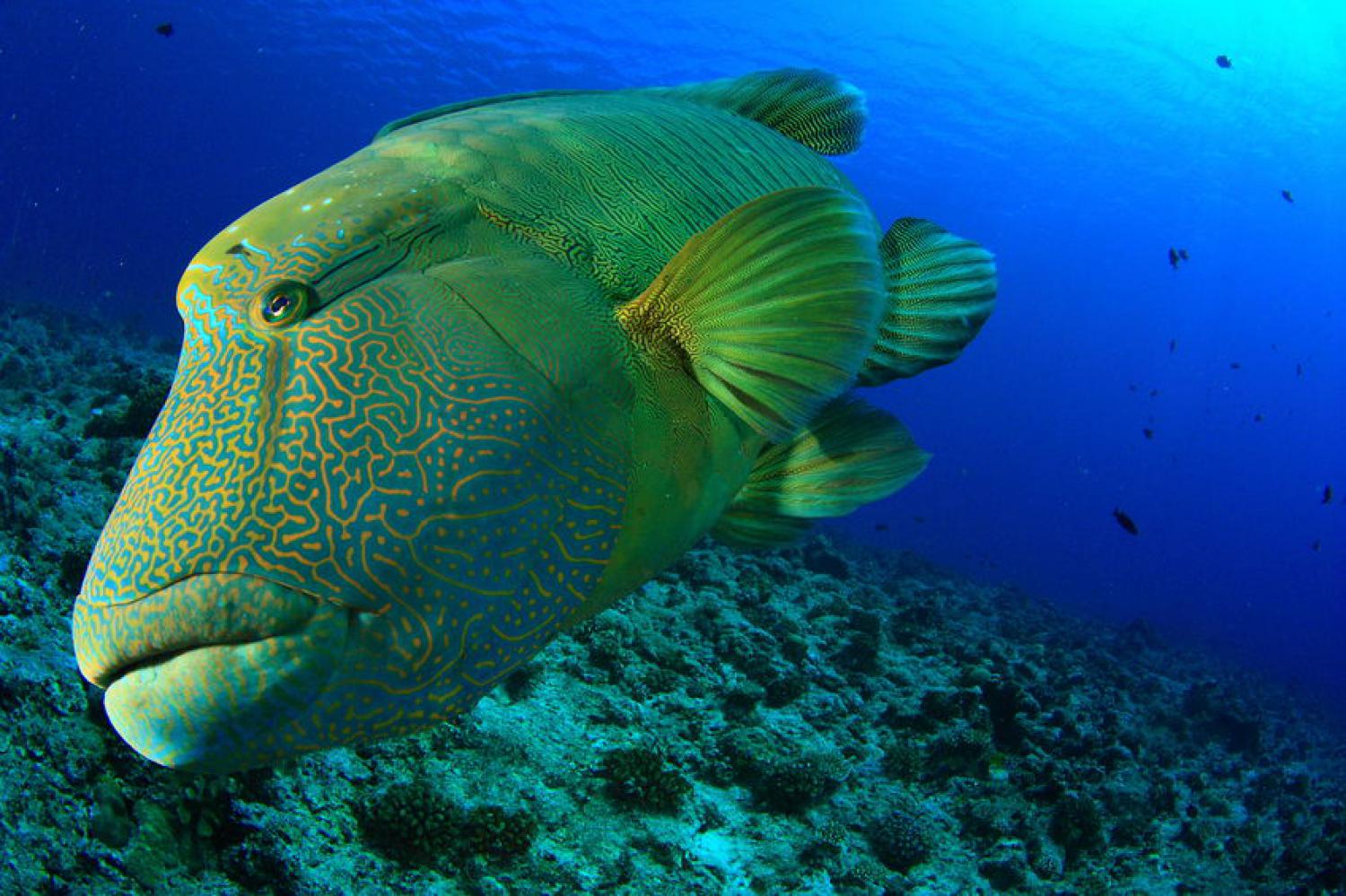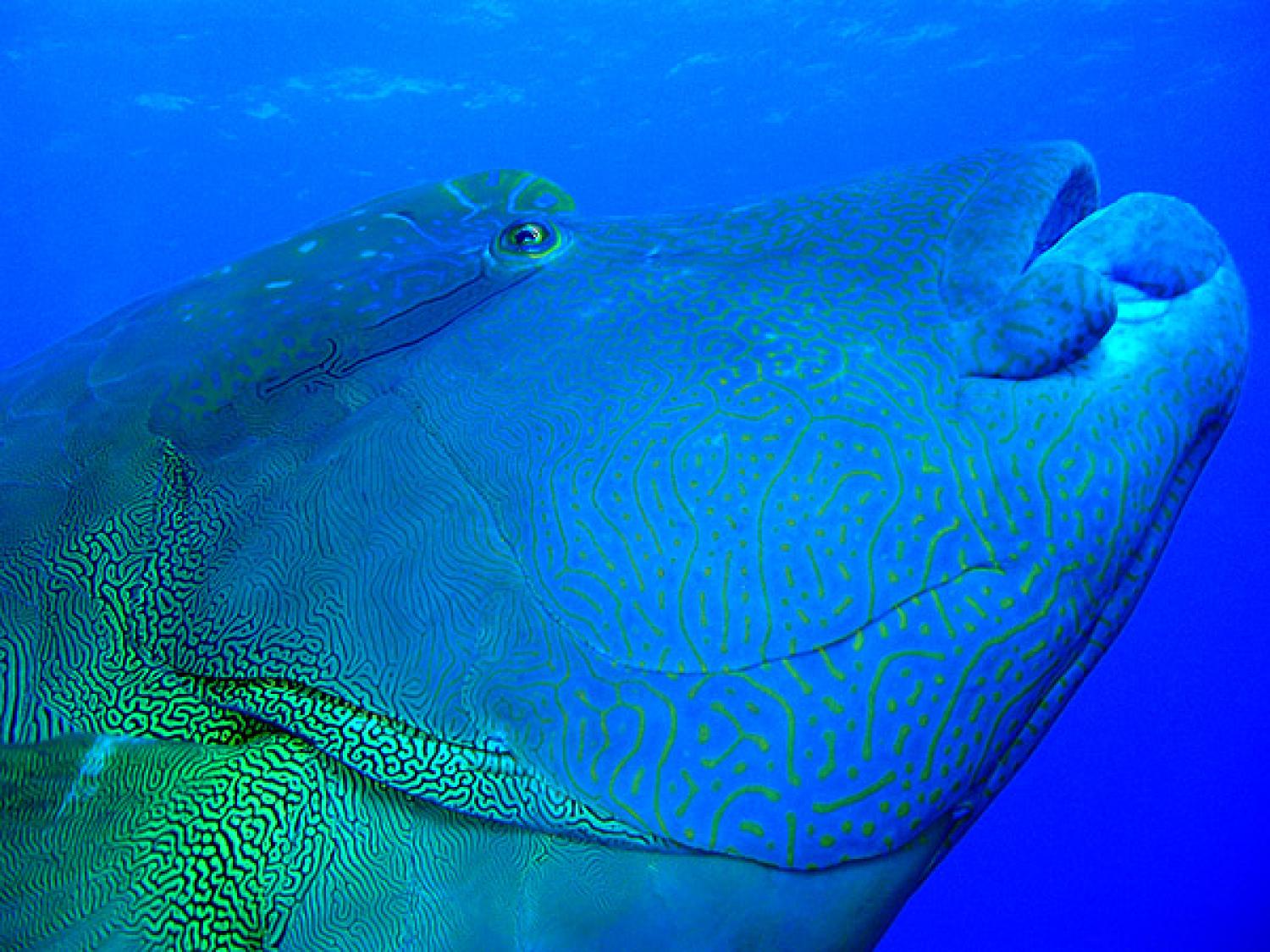Species of Thailand
Humphead wrasse
Cheilinus undulatus
Edward Rüppell, 1835
The humphead wrasse, Cheilinus undulatus, is a species of wrasse mainly found on coral reefs in the Indo-Pacific region. It is also known as the Māori wrasse, Napoleon wrasse, Napoleon fish, Napoleonfish; and so mei 蘇眉 (Cantonese), mameng (Filipino), and merer in the Pohnpeian language of the Caroline Islands.
Common Name
Humphead wrasse or colloquially, derpfish
Habitat
Salt water
Utilization
Fishery: Small Trading; Aquaculture: Trade; Game: Fishing; Aquarium: Trade
Description
The humphead wrasse is the largest living member of the family Labridae, with males reaching 6 ft (2 m) in length, while females rarely exceed about 3 ft (1 m). It has thick, fleshy lips, and a hump, females are red-orange above, and red-orange to white below. Some males grow very large, with one unconfirmed report of a humphead wrasse that was 7.75 ft (2.29 m) long and weighed 420 lbs (190.5 kg).
Ecology
Adults are commonly found on steep coral reef slopes, channel slopes, and lagoon reefs in water 3 to 330 ft (1–100 m) deep.
They are very opportunistic predators, preying primarily on crustaceans, mollusks (particularly gastropods), fish, and echinoderms. They are one of the few predators of toxic animals such as the sea hare Aplysia and Napolian Junior Ostraciidae and have even been reported preying on crown-of-thorns starfish. This species actively selects branching hard and soft corals and seagrasses at settlement. Juveniles tend to prefer a more cryptic existence in areas of dense branching corals, bushy macroalgae, or seagrasses, while larger individuals and adults prefer to occupy limited home ranges in more open habitat on the edges of reefs, channels, and reef passes. The species is most often observed in solitary male-female pairs, or groups of two to seven individuals.
Reproduction
Individuals become sexually mature at four to six years, and females are known to live for around 50 years, whereas males live a slightly shorter 45 years. Humphead wrasses are protogynous hermaphrodites, with some members of the population becoming male at about 9 years old The factors that control the timing of sex change are not yet known. Adults move to the down-current end of the reef and form local spawning aggregations (they concentrate to spawn) at certain times of the year.
Conservation
The humphead wrasse is long-lived, but has a very slow breeding rate. Its numbers have declined due to a number of threats, including:
# Intensive and species-specific removal in the live reef food fish trade throughout its core range in South-East Asia
# Spearfishing at night with SCUBA gear
# Destructive fishing techniques, including sodium cyanide and dynamite
# Habitat loss and degradation
# Juveniles being taken from the wild and raised or “cultured” in floating net cages until saleable size
# A developing export market for juvenile humphead wrasse for the marine aquarium trade
# Lack of coordinated, consistent national and regional management
# Illegal, unregulated, or unreported fisheries
The fish is listed on the IUCN Red list as Endangered and on Appendix II of CITES.
The species has historically been fished commercially in northern Australia, but has been protected in Queensland since 2003 and Western Australia since 1998.
In Guangdong Province, southern mainland China, permits are required for the sale of this species; Indonesia allows fishing only for research, mariculture, and licensed artisanal fishing; the Maldives instituted an export ban in 1995; Papua New Guinea prohibits export of fish over 2 ft (65 cm) total length; and Niue has banned all fishing for this species.
The humphead wrasse is a U.S. National Marine Fisheries Service Species of Concern. Species of Concern are those species about which the NMFS, has some concerns regarding status and threats, but for which insufficient information is available to indicate a need to list the species under the Endangered Species Act.
This article uses material from Wikipedia released under the Creative Commons Attribution-Share-Alike Licence 3.0. Eventual photos shown in this page may or may not be from Wikipedia, please see the license details for photos in photo by-lines.
Scientific classification
- Kingdom
- Animalia
- Phylum
- Chordata
- Class
- Actinopterygii
- Order
- Perciformes
- Family
- Labridae
- Genus
- Cheilinus
- Species
- Cheilinus undulatus
Common names
- English:
- Giant wrasse
- Humphead
- Humphead wrasse
- Maori wrasse
- Napoleon wrasse
- Truck wrasse
- Undulate wrasse
- French: Napoleon
Synonyms
- Cheilinus rostratus, Cartier (1874)
- Cheilinus godeffroyi, Albert Charles Lewis Günther (1872)
- Cheilinus mertensii, Achille Valenciennes (1840)
Conservation status

Endangered (IUCN3.1)
Photos
Please help us review our species pages if wrong photos are used or any other details in the page is wrong. We can be reached via our contact us page.
Range Map

- Similan Islands

